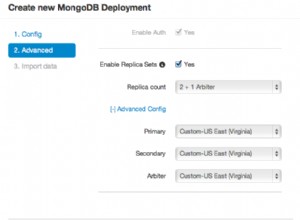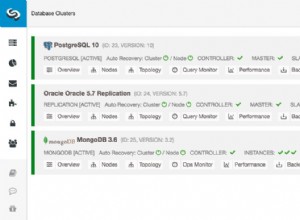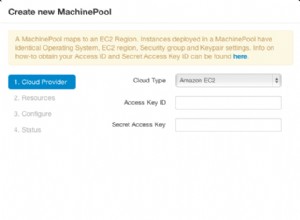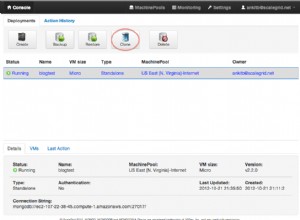Non è necessario analizzare il JSON. Tutto qui può effettivamente essere fatto direttamente con LINQ o le interfacce Aggregate Fluent.
Sto solo usando alcune lezioni dimostrative perché la domanda non dà molto su cui andare avanti.
Configurazione
Fondamentalmente abbiamo due raccolte qui, essendo
entità
{ "_id" : ObjectId("5b08ceb40a8a7614c70a5710"), "name" : "A" }
{ "_id" : ObjectId("5b08ceb40a8a7614c70a5711"), "name" : "B" }
e altri
{
"_id" : ObjectId("5b08cef10a8a7614c70a5712"),
"entity" : ObjectId("5b08ceb40a8a7614c70a5710"),
"name" : "Sub-A"
}
{
"_id" : ObjectId("5b08cefd0a8a7614c70a5713"),
"entity" : ObjectId("5b08ceb40a8a7614c70a5711"),
"name" : "Sub-B"
}
E un paio di classi a cui associarli, proprio come esempi molto semplici:
public class Entity
{
public ObjectId id;
public string name { get; set; }
}
public class Other
{
public ObjectId id;
public ObjectId entity { get; set; }
public string name { get; set; }
}
public class EntityWithOthers
{
public ObjectId id;
public string name { get; set; }
public IEnumerable<Other> others;
}
public class EntityWithOther
{
public ObjectId id;
public string name { get; set; }
public Other others;
}
Query
Interfaccia fluida
var listNames = new[] { "A", "B" };
var query = entities.Aggregate()
.Match(p => listNames.Contains(p.name))
.Lookup(
foreignCollection: others,
localField: e => e.id,
foreignField: f => f.entity,
@as: (EntityWithOthers eo) => eo.others
)
.Project(p => new { p.id, p.name, other = p.others.First() } )
.Sort(new BsonDocument("other.name",-1))
.ToList();
Richiesta inviata al server:
[
{ "$match" : { "name" : { "$in" : [ "A", "B" ] } } },
{ "$lookup" : {
"from" : "others",
"localField" : "_id",
"foreignField" : "entity",
"as" : "others"
} },
{ "$project" : {
"id" : "$_id",
"name" : "$name",
"other" : { "$arrayElemAt" : [ "$others", 0 ] },
"_id" : 0
} },
{ "$sort" : { "other.name" : -1 } }
]
Probabilmente il più facile da capire poiché l'interfaccia fluente è fondamentalmente la stessa della struttura BSON generale. La $lookup stage ha tutti gli stessi argomenti e $arrayElemAt è rappresentato con First() . Per il $sort puoi semplicemente fornire un documento BSON o un'altra espressione valida.
Un'alternativa è la nuova forma espressiva di $lookup con un'istruzione sub-pipeline per MongoDB 3.6 e versioni successive.
BsonArray subpipeline = new BsonArray();
subpipeline.Add(
new BsonDocument("$match",new BsonDocument(
"$expr", new BsonDocument(
"$eq", new BsonArray { "$$entity", "$entity" }
)
))
);
var lookup = new BsonDocument("$lookup",
new BsonDocument("from", "others")
.Add("let", new BsonDocument("entity", "$_id"))
.Add("pipeline", subpipeline)
.Add("as","others")
);
var query = entities.Aggregate()
.Match(p => listNames.Contains(p.name))
.AppendStage<EntityWithOthers>(lookup)
.Unwind<EntityWithOthers, EntityWithOther>(p => p.others)
.SortByDescending(p => p.others.name)
.ToList();
Richiesta inviata al server:
[
{ "$match" : { "name" : { "$in" : [ "A", "B" ] } } },
{ "$lookup" : {
"from" : "others",
"let" : { "entity" : "$_id" },
"pipeline" : [
{ "$match" : { "$expr" : { "$eq" : [ "$$entity", "$entity" ] } } }
],
"as" : "others"
} },
{ "$unwind" : "$others" },
{ "$sort" : { "others.name" : -1 } }
]
Il "Builder" fluente non supporta ancora direttamente la sintassi, né le espressioni LINQ supportano il $expr operatore, tuttavia puoi ancora costruire usando BsonDocument e BsonArray o altre espressioni valide. Qui "digitiamo" anche il $unwind risultato per applicare un $sort utilizzando un'espressione anziché un BsonDocument come mostrato in precedenza.
A parte altri usi, un compito principale di una "sotto-pipeline" è ridurre i documenti restituiti nell'array di destinazione di $lookup . Anche il $unwind qui serve allo scopo di essere effettivamente "unito" nel $lookup istruzione sull'esecuzione del server, quindi questo è in genere più efficiente del semplice afferrare il primo elemento dell'array risultante.
Partecipa al gruppo interrogabile
var query = entities.AsQueryable()
.Where(p => listNames.Contains(p.name))
.GroupJoin(
others.AsQueryable(),
p => p.id,
o => o.entity,
(p, o) => new { p.id, p.name, other = o.First() }
)
.OrderByDescending(p => p.other.name);
Richiesta inviata al server:
[
{ "$match" : { "name" : { "$in" : [ "A", "B" ] } } },
{ "$lookup" : {
"from" : "others",
"localField" : "_id",
"foreignField" : "entity",
"as" : "o"
} },
{ "$project" : {
"id" : "$_id",
"name" : "$name",
"other" : { "$arrayElemAt" : [ "$o", 0 ] },
"_id" : 0
} },
{ "$sort" : { "other.name" : -1 } }
]
Questo è quasi identico ma usa solo l'interfaccia diversa e produce un'istruzione BSON leggermente diversa, e in realtà solo a causa della denominazione semplificata nelle istruzioni funzionali. Questo fa apparire l'altra possibilità di usare semplicemente un $unwind come prodotto da un SelectMany() :
var query = entities.AsQueryable()
.Where(p => listNames.Contains(p.name))
.GroupJoin(
others.AsQueryable(),
p => p.id,
o => o.entity,
(p, o) => new { p.id, p.name, other = o }
)
.SelectMany(p => p.other, (p, other) => new { p.id, p.name, other })
.OrderByDescending(p => p.other.name);
Richiesta inviata al server:
[
{ "$match" : { "name" : { "$in" : [ "A", "B" ] } } },
{ "$lookup" : {
"from" : "others",
"localField" : "_id",
"foreignField" : "entity",
"as" : "o"
}},
{ "$project" : {
"id" : "$_id",
"name" : "$name",
"other" : "$o",
"_id" : 0
} },
{ "$unwind" : "$other" },
{ "$project" : {
"id" : "$id",
"name" : "$name",
"other" : "$other",
"_id" : 0
}},
{ "$sort" : { "other.name" : -1 } }
]
Normalmente posizionando un $unwind seguendo direttamente $lookup è in realtà un "modello ottimizzato" per il framework di aggregazione. Tuttavia il driver .NET rovina tutto in questa combinazione forzando un $project in mezzo invece di usare la denominazione implicita su "as" . In caso contrario, questo è effettivamente meglio di $arrayElemAt quando sai di avere "uno" risultato correlato. Se vuoi il $unwind "coalescenza", allora è meglio usare l'interfaccia fluente, o una forma diversa come dimostrato più avanti.
Querable Naturale
var query = from p in entities.AsQueryable()
where listNames.Contains(p.name)
join o in others.AsQueryable() on p.id equals o.entity into joined
select new { p.id, p.name, other = joined.First() }
into p
orderby p.other.name descending
select p;
Richiesta inviata al server:
[
{ "$match" : { "name" : { "$in" : [ "A", "B" ] } } },
{ "$lookup" : {
"from" : "others",
"localField" : "_id",
"foreignField" : "entity",
"as" : "joined"
} },
{ "$project" : {
"id" : "$_id",
"name" : "$name",
"other" : { "$arrayElemAt" : [ "$joined", 0 ] },
"_id" : 0
} },
{ "$sort" : { "other.name" : -1 } }
]
Tutto abbastanza familiare e davvero solo fino alla denominazione funzionale. Proprio come con l'utilizzo di $unwind opzione:
var query = from p in entities.AsQueryable()
where listNames.Contains(p.name)
join o in others.AsQueryable() on p.id equals o.entity into joined
from sub_o in joined.DefaultIfEmpty()
select new { p.id, p.name, other = sub_o }
into p
orderby p.other.name descending
select p;
Richiesta inviata al server:
[
{ "$match" : { "name" : { "$in" : [ "A", "B" ] } } },
{ "$lookup" : {
"from" : "others",
"localField" : "_id",
"foreignField" : "entity",
"as" : "joined"
} },
{ "$unwind" : {
"path" : "$joined", "preserveNullAndEmptyArrays" : true
} },
{ "$project" : {
"id" : "$_id",
"name" : "$name",
"other" : "$joined",
"_id" : 0
} },
{ "$sort" : { "other.name" : -1 } }
]
Che in realtà sta usando il modulo "coalescenza ottimizzata". Il traduttore insiste ancora per aggiungere un $project poiché abbiamo bisogno dell'intermedio select per rendere valida la dichiarazione.
Riepilogo
Quindi ci sono molti modi per arrivare essenzialmente a quella che è fondamentalmente la stessa istruzione di query con esattamente gli stessi risultati. Mentre "potresti" analizzare il JSON in BsonDocument form e invialo al fluente Aggregate() comando, in genere è meglio utilizzare i builder naturali o le interfacce LINQ poiché si associano facilmente alla stessa istruzione.
Le opzioni con $unwind sono in gran parte mostrati perché anche con una corrispondenza "singolare" quella forma di "coalescenza" è in realtà molto più ottimale rispetto all'utilizzo di $arrayElemAt per prendere il "primo" elemento dell'array. Questo diventa ancora più importante con considerazioni su cose come il limite BSON dove il $lookup l'array di destinazione potrebbe far sì che il documento padre superi i 16 MB senza ulteriori filtri. C'è un altro post qui su Aggregate $lookup La dimensione totale dei documenti nella pipeline corrispondente supera la dimensione massima del documento in cui discuto effettivamente di come evitare che tale limite venga raggiunto usando tali opzioni o altri Lookup() sintassi disponibile solo per l'interfaccia fluente in questo momento.




